TOYOTA BZ4X 2022 Owners Manual (in English)
Manufacturer: TOYOTA, Model Year: 2022, Model line: BZ4X, Model: TOYOTA BZ4X 2022Pages: 674, PDF Size: 120.02 MB
Page 121 of 674
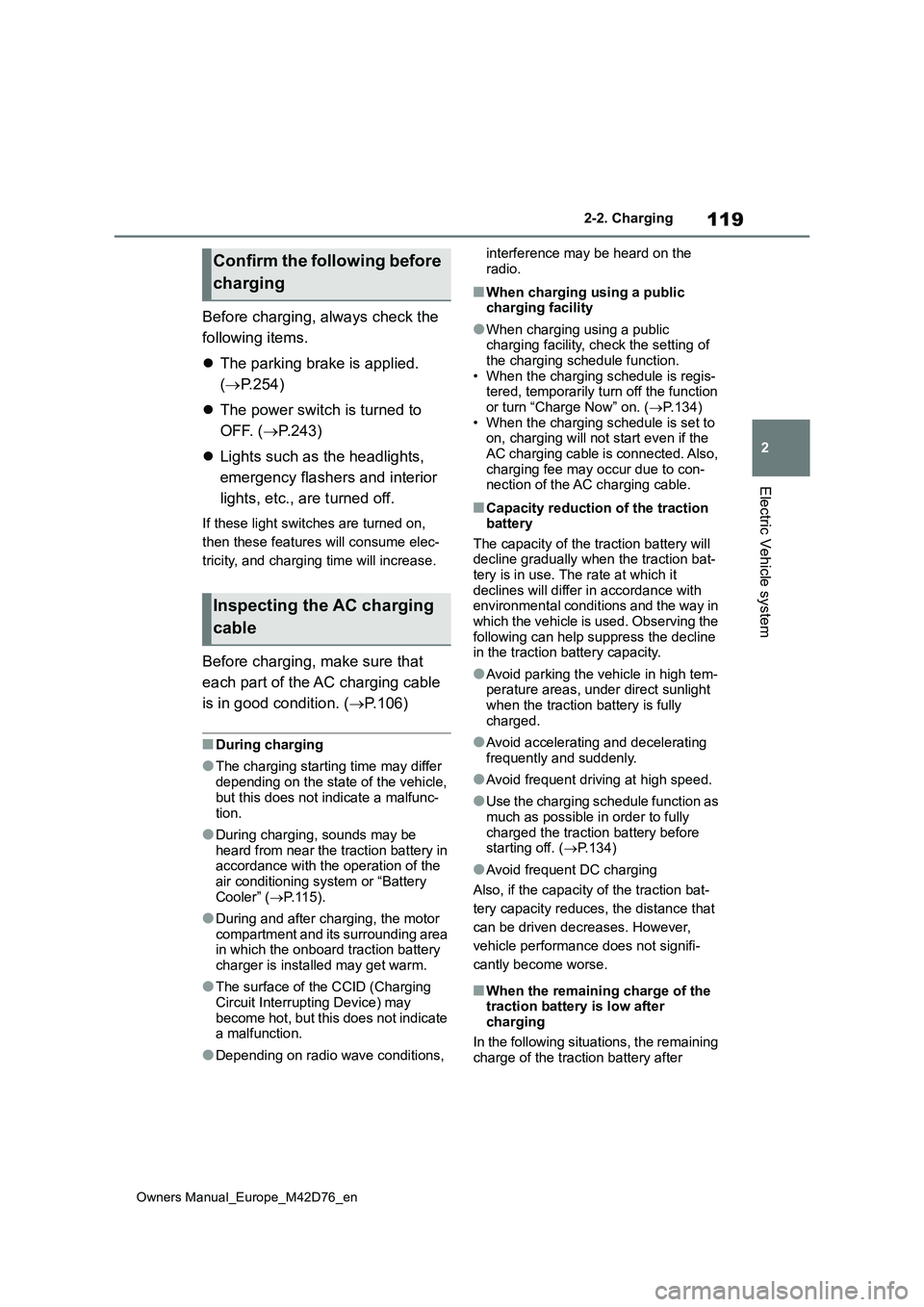
119
2
Owners Manual_Europe_M42D76_en
2-2. Charging
Electric Vehicle system
Before charging, always check the
following items.
The parking brake is applied.
( P.254)
The power switch is turned to
OFF. ( P.243)
Lights such as the headlights,
emergency flashers and interior
lights, etc., are turned off.
If these light switches are turned on,
then these features will consume elec-
tricity, and charging time will increase.
Before charging, make sure that
each part of the AC charging cable
is in good condition. ( P.106)
■During charging
●The charging starting time may differ
depending on the state of the vehicle, but this does not indicate a malfunc-
tion.
●During charging, sounds may be
heard from near the traction battery in accordance with the operation of the air conditioning system or “Battery
Cooler” ( P.115).
●During and after charging, the motor
compartment and its surrounding area in which the onboard traction battery charger is installed may get warm.
●The surface of the CCID (Charging Circuit Interrupting Device) may
become hot, but this does not indicate a malfunction.
●Depending on radio wave conditions,
interference may be heard on the
radio.
■When charging using a public charging facility
●When charging using a public charging facility, check the setting of the charging schedule function.
• When the charging schedule is regis- tered, temporarily turn off the function or turn “Charge Now” on. ( P.134)
• When the charging schedule is set to on, charging will not start even if the AC charging cable is connected. Also,
charging fee may occur due to con- nection of the AC charging cable.
■Capacity reduction of the traction battery
The capacity of the traction battery will decline gradually when the traction bat-tery is in use. The rate at which it
declines will differ in accordance with environmental conditions and the way in which the vehicle is used. Observing the
following can help suppress the decline in the traction battery capacity.
●Avoid parking the vehicle in high tem-perature areas, under direct sunlight when the traction battery is fully
charged.
●Avoid accelerating and decelerating
frequently and suddenly.
●Avoid frequent driving at high speed.
●Use the charging schedule function as much as possible in order to fully
charged the traction battery before starting off. ( P.134)
●Avoid frequent DC charging
Also, if the capacity of the traction bat-
tery capacity reduces, the distance that
can be driven decreases. However,
vehicle performance does not signifi-
cantly become worse.
■When the remaining charge of the traction battery is low after charging
In the following situations, the remaining charge of the traction battery after
Confirm the following before
charging
Inspecting the AC charging
cable
Page 122 of 674
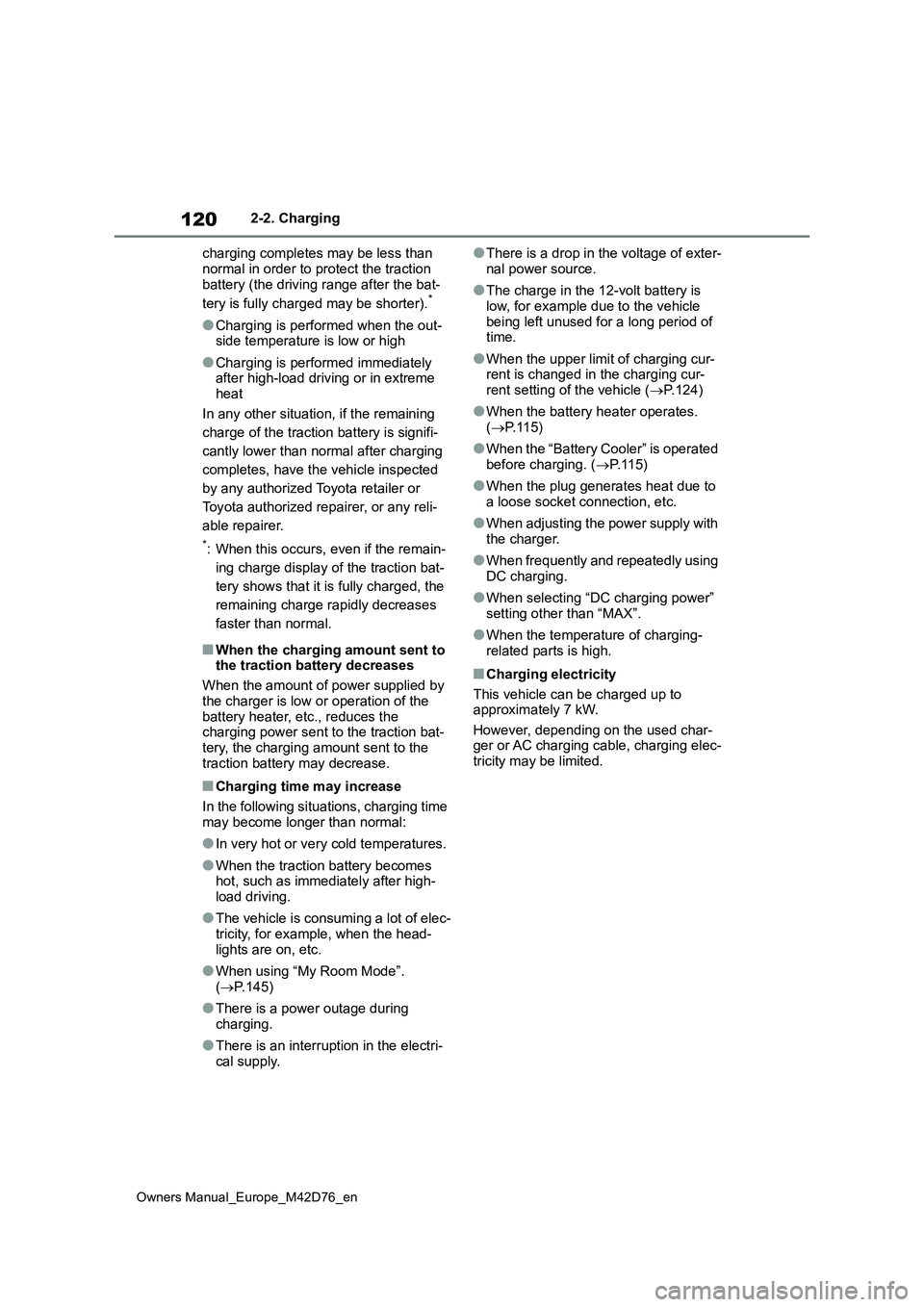
120
Owners Manual_Europe_M42D76_en
2-2. Charging
charging completes may be less than
normal in order to protect the traction battery (the driving range after the bat-
tery is fully charged may be shorter).*
●Charging is performed when the out- side temperature is low or high
●Charging is performed immediately after high-load driving or in extreme
heat
In any other situation, if the remaining
charge of the traction battery is signifi-
cantly lower than normal after charging
completes, have the vehicle inspected
by any authorized Toyota retailer or
Toyota authorized repairer, or any reli-
able repairer.
*: When this occurs, even if the remain-
ing charge display of the traction bat-
tery shows that it is fully charged, the
remaining charge rapidly decreases
faster than normal.
■When the charging amount sent to the traction battery decreases
When the amount of power supplied by
the charger is low or operation of the battery heater, etc., reduces the charging power sent to the traction bat-
tery, the charging amount sent to the traction battery may decrease.
■Charging time may increase
In the following situations, charging time
may become longer than normal:
●In very hot or very cold temperatures.
●When the traction battery becomes hot, such as immediately after high-
load driving.
●The vehicle is consuming a lot of elec-
tricity, for example, when the head- lights are on, etc.
●When using “My Room Mode”. ( P.145)
●There is a power outage during charging.
●There is an interruption in the electri-cal supply.
●There is a drop in the voltage of exter-
nal power source.
●The charge in the 12-volt battery is
low, for example due to the vehicle being left unused for a long period of time.
●When the upper limit of charging cur-rent is changed in the charging cur-
rent setting of the vehicle ( P.124)
●When the battery heater operates.
( P. 1 1 5 )
●When the “Battery Cooler” is operated
before charging. ( P. 1 1 5 )
●When the plug generates heat due to
a loose socket connection, etc.
●When adjusting the power supply with
the charger.
●When frequently and repeatedly using
DC charging.
●When selecting “DC charging power”
setting other than “MAX”.
●When the temperature of charging-
related parts is high.
■Charging electricity
This vehicle can be charged up to approximately 7 kW.
However, depending on the used char- ger or AC charging cable, charging elec-tricity may be limited.
Page 123 of 674
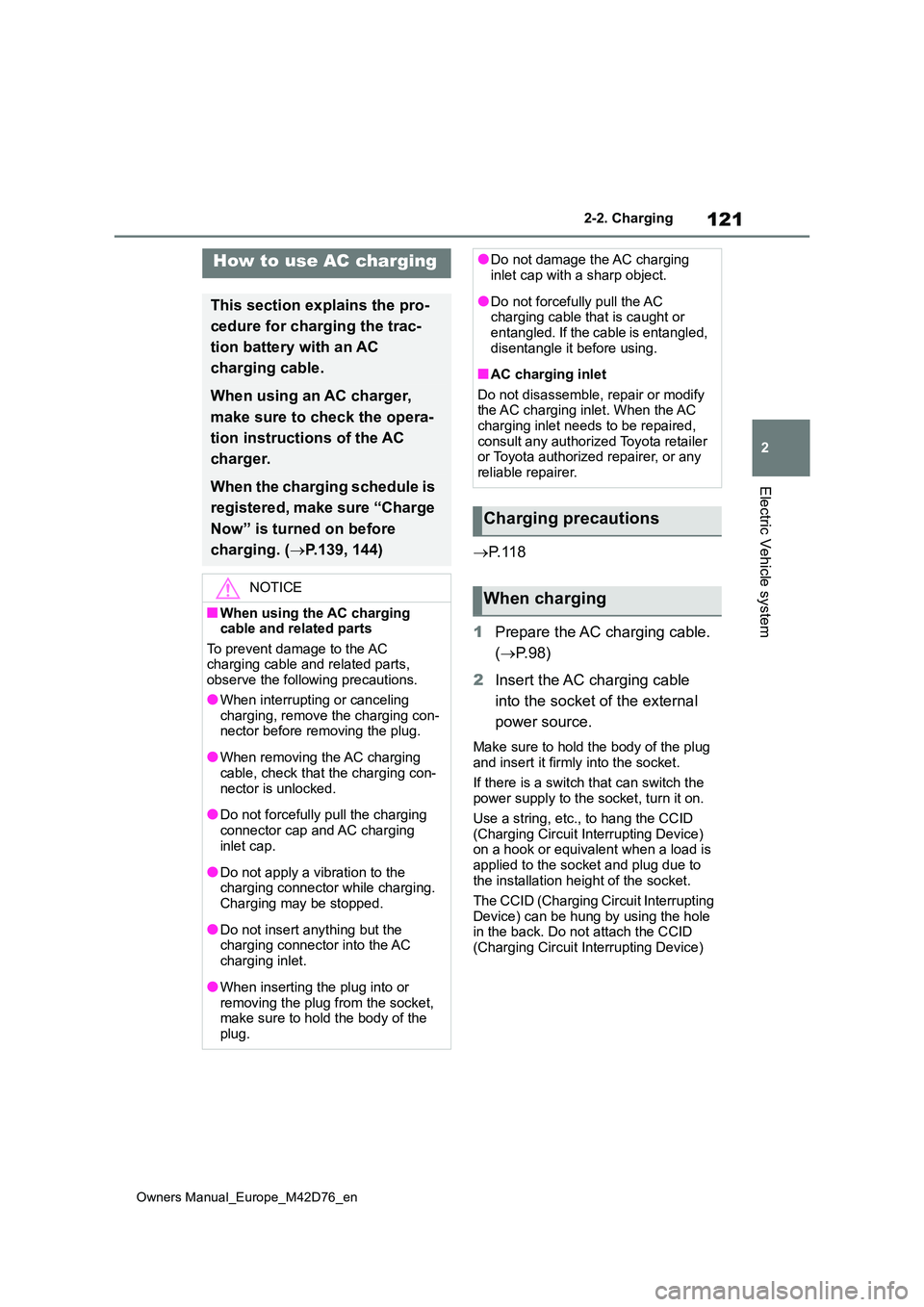
121
2
Owners Manual_Europe_M42D76_en
2-2. Charging
Electric Vehicle system
P. 1 1 8
1 Prepare the AC charging cable.
( P. 9 8 )
2 Insert the AC charging cable
into the socket of the external
power source.
Make sure to hold the body of the plug
and insert it firmly into the socket.
If there is a switch that can switch the power supply to the socket, turn it on.
Use a string, etc., to hang the CCID (Charging Circuit Interrupting Device) on a hook or equivalent when a load is
applied to the socket and plug due to the installation height of the socket.
The CCID (Charging Circuit Interrupting
Device) can be hung by using the hole in the back. Do not attach the CCID (Charging Circuit Interrupting Device)
How to use AC charging
This section explains the pro-
cedure for charging the trac-
tion battery with an AC
charging cable.
When using an AC charger,
make sure to check the opera-
tion instructions of the AC
charger.
When the charging schedule is
registered, make sure “Charge
Now” is turned on before
charging. ( P.139, 144)
NOTICE
■When using the AC charging cable and related parts
To prevent damage to the AC charging cable and related parts, observe the following precautions.
●When interrupting or canceling charging, remove the charging con-nector before removing the plug.
●When removing the AC charging cable, check that the charging con-
nector is unlocked.
●Do not forcefully pull the charging
connector cap and AC charging inlet cap.
●Do not apply a vibration to the charging connector while charging. Charging may be stopped.
●Do not insert anything but the charging connector into the AC
charging inlet.
●When inserting the plug into or
removing the plug from the socket, make sure to hold the body of the plug.
●Do not damage the AC charging inlet cap with a sharp object.
●Do not forcefully pull the AC charging cable that is caught or entangled. If the cable is entangled,
disentangle it before using.
■AC charging inlet
Do not disassemble, repair or modify the AC charging inlet. When the AC charging inlet needs to be repaired,
consult any authorized Toyota retailer or Toyota authorized repairer, or any reliable repairer.
Charging precautions
When charging
Page 124 of 674

122
Owners Manual_Europe_M42D76_en
2-2. Charging
to the wall with screws.
3 Unlock the doors and open the
charging port lid. ( P. 9 5 )
The charging inlet light will illumi-
nate.
4 Open the AC charging inlet cap.
5 Remove the charging connec-
tor cap and secure it to the
cable.
6 Make sure to hold the body of
the charging connector and
insert it firmly and fully into the
AC charging inlet.
When connecting the charging connec- tor into the AC charging inlet, make sure that the identification symbols are
the same.
When the charging connector is inserted straight as far as possible, it
will automatically lock.
Check that the charging indicator illumi- nates. If the charging indicator does not
illuminate, the charging connector is not
locked.*
Page 125 of 674
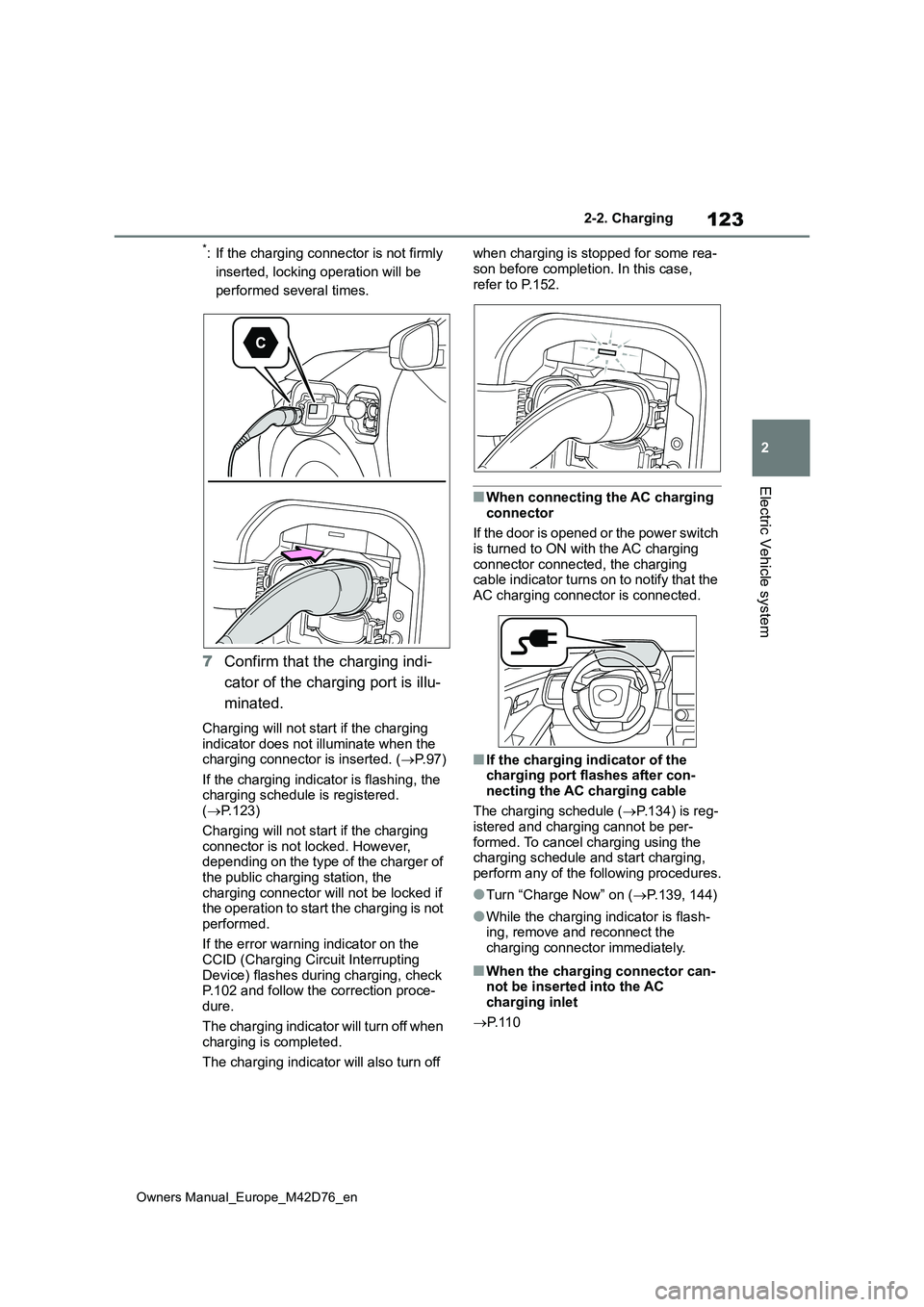
123
2
Owners Manual_Europe_M42D76_en
2-2. Charging
Electric Vehicle system
*: If the charging connector is not firmly
inserted, locking operation will be
performed several times.
7 Confirm that the charging indi-
cator of the charging port is illu-
minated.
Charging will not start if the charging indicator does not illuminate when the charging connector is inserted. ( P. 9 7 )
If the charging indicator is flashing, the charging schedule is registered. ( P.123)
Charging will not start if the charging connector is not locked. However, depending on the type of the charger of
the public charging station, the charging connector will not be locked if the operation to start the charging is not
performed.
If the error warning indicator on the CCID (Charging Circuit Interrupting
Device) flashes during charging, check P.102 and follow the correction proce-dure.
The charging indicator will turn off when charging is completed.
The charging indicator will also turn off
when charging is stopped for some rea-
son before completion. In this case, refer to P.152.
■When connecting the AC charging
connector
If the door is opened or the power switch is turned to ON with the AC charging
connector connected, the charging cable indicator turns on to notify that the AC charging connector is connected.
■If the charging indicator of the charging port flashes after con-
necting the AC charging cable
The charging schedule ( P.134) is reg- istered and charging cannot be per-
formed. To cancel charging using the charging schedule and start charging, perform any of the following procedures.
●Turn “Charge Now” on ( P.139, 144)
●While the charging indicator is flash- ing, remove and reconnect the
charging connector immediately.
■When the charging connector can- not be inserted into the AC charging inlet
P. 1 1 0
Page 126 of 674
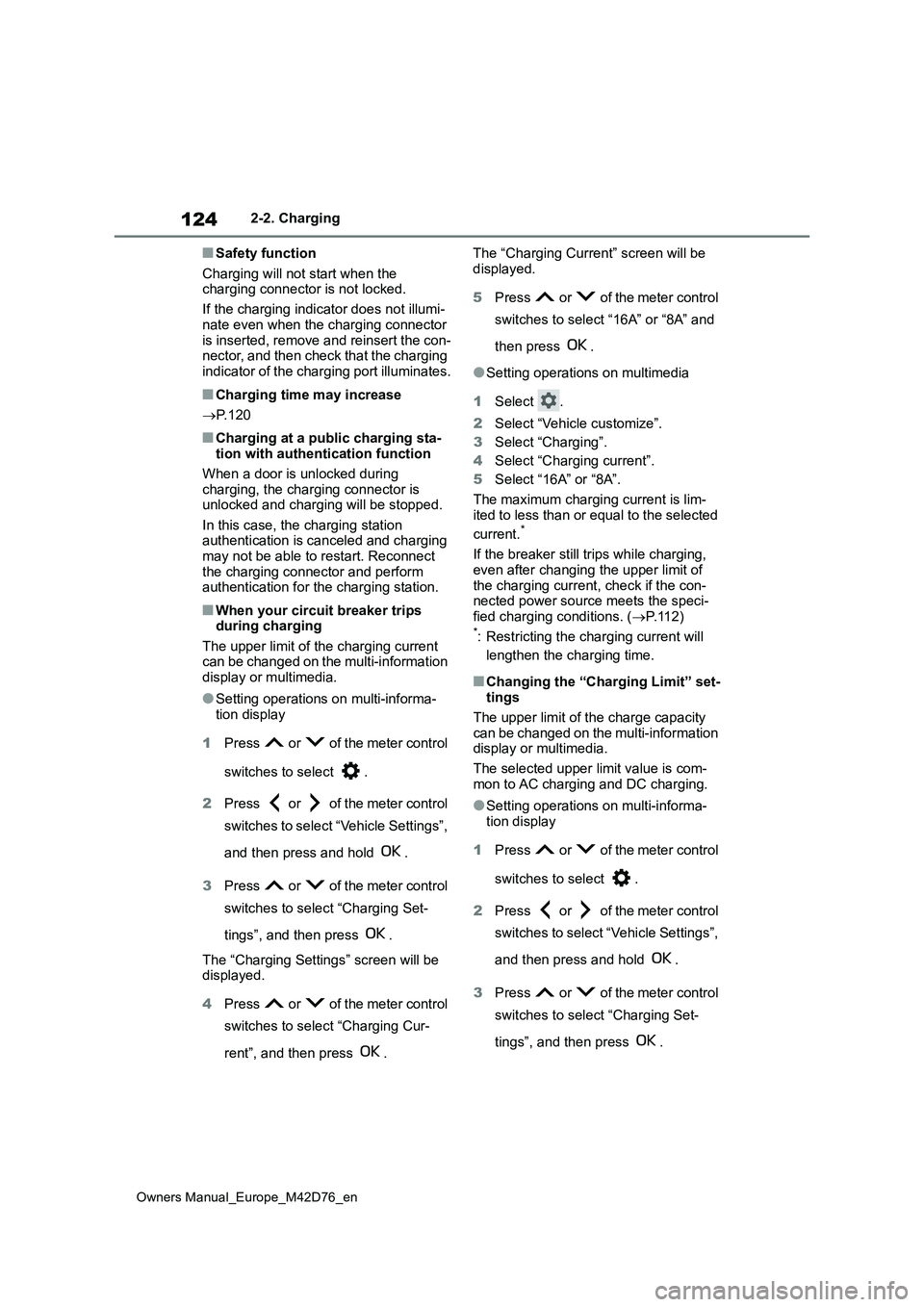
124
Owners Manual_Europe_M42D76_en
2-2. Charging
■Safety function
Charging will not start when the charging connector is not locked.
If the charging indicator does not illumi-
nate even when the charging connector is inserted, remove and reinsert the con-nector, and then check that the charging
indicator of the charging port illuminates.
■Charging time may increase
P. 1 2 0
■Charging at a public charging sta- tion with authentication function
When a door is unlocked during charging, the charging connector is unlocked and charging will be stopped.
In this case, the charging station authentication is canceled and charging may not be able to restart. Reconnect
the charging connector and perform authentication for the charging station.
■When your circuit breaker trips during charging
The upper limit of the charging current can be changed on the multi-information display or multimedia.
●Setting operations on multi-informa-tion display
1 Press or of the meter control
switches to select .
2 Press or of the meter control
switches to select “Vehicle Settings”,
and then press and hold .
3 Press or of the meter control
switches to select “Charging Set-
tings”, and then press .
The “Charging Settings” screen will be displayed.
4 Press or of the meter control
switches to select “Charging Cur-
rent”, and then press .
The “Charging Current” screen will be
displayed.
5 Press or of the meter control
switches to select “16A” or “8A” and
then press .
●Setting operations on multimedia
1 Select .
2 Select “Vehicle customize”.
3 Select “Charging”.
4 Select “Charging current”.
5 Select “16A” or “8A”.
The maximum charging current is lim-
ited to less than or equal to the selected
current.*
If the breaker still trips while charging,
even after changing the upper limit of the charging current, check if the con-nected power source meets the speci-
fied charging conditions. ( P.112)*: Restricting the charging current will
lengthen the charging time.
■Changing the “Charging Limit” set- tings
The upper limit of the charge capacity
can be changed on the multi-information display or multimedia.
The selected upper limit value is com-
mon to AC charging and DC charging.
●Setting operations on multi-informa-
tion display
1 Press or of the meter control
switches to select .
2 Press or of the meter control
switches to select “Vehicle Settings”,
and then press and hold .
3 Press or of the meter control
switches to select “Charging Set-
tings”, and then press .
Page 127 of 674
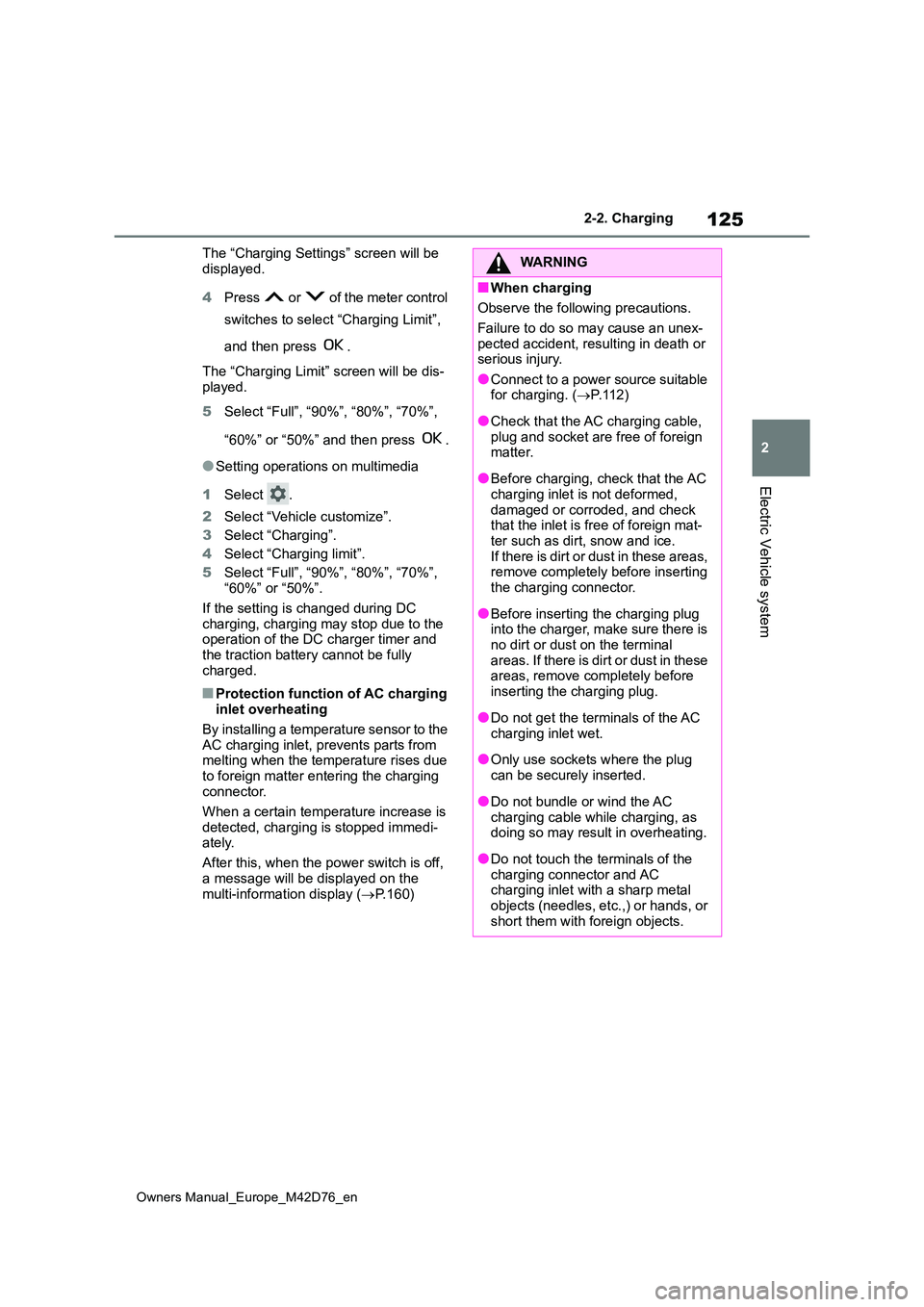
125
2
Owners Manual_Europe_M42D76_en
2-2. Charging
Electric Vehicle system
The “Charging Settings” screen will be
displayed.
4 Press or of the meter control
switches to select “Charging Limit”,
and then press .
The “Charging Limit” screen will be dis- played.
5 Select “Full”, “90%”, “80%”, “70%”,
“60%” or “50%” and then press .
●Setting operations on multimedia
1 Select .
2 Select “Vehicle customize”.
3 Select “Charging”.
4 Select “Charging limit”.
5 Select “Full”, “90%”, “80%”, “70%”, “60%” or “50%”.
If the setting is changed during DC charging, charging may stop due to the operation of the DC charger timer and
the traction battery cannot be fully charged.
■Protection function of AC charging inlet overheating
By installing a temperature sensor to the AC charging inlet, prevents parts from melting when the temperature rises due
to foreign matter entering the charging connector.
When a certain temperature increase is
detected, charging is stopped immedi- ately.
After this, when the power switch is off,
a message will be displayed on the multi-information display ( P.160)
WARNING
■When charging
Observe the following precautions.
Failure to do so may cause an unex- pected accident, resulting in death or serious injury.
●Connect to a power source suitable for charging. ( P.112)
●Check that the AC charging cable, plug and socket are free of foreign matter.
●Before charging, check that the AC charging inlet is not deformed,
damaged or corroded, and check that the inlet is free of foreign mat-ter such as dirt, snow and ice.
If there is dirt or dust in these areas, remove completely before inserting the charging connector.
●Before inserting the charging plug into the charger, make sure there is
no dirt or dust on the terminal areas. If there is dirt or dust in these areas, remove completely before
inserting the charging plug.
●Do not get the terminals of the AC
charging inlet wet.
●Only use sockets where the plug
can be securely inserted.
●Do not bundle or wind the AC
charging cable while charging, as doing so may result in overheating.
●Do not touch the terminals of the charging connector and AC charging inlet with a sharp metal
objects (needles, etc.,) or hands, or short them with foreign objects.
Page 128 of 674
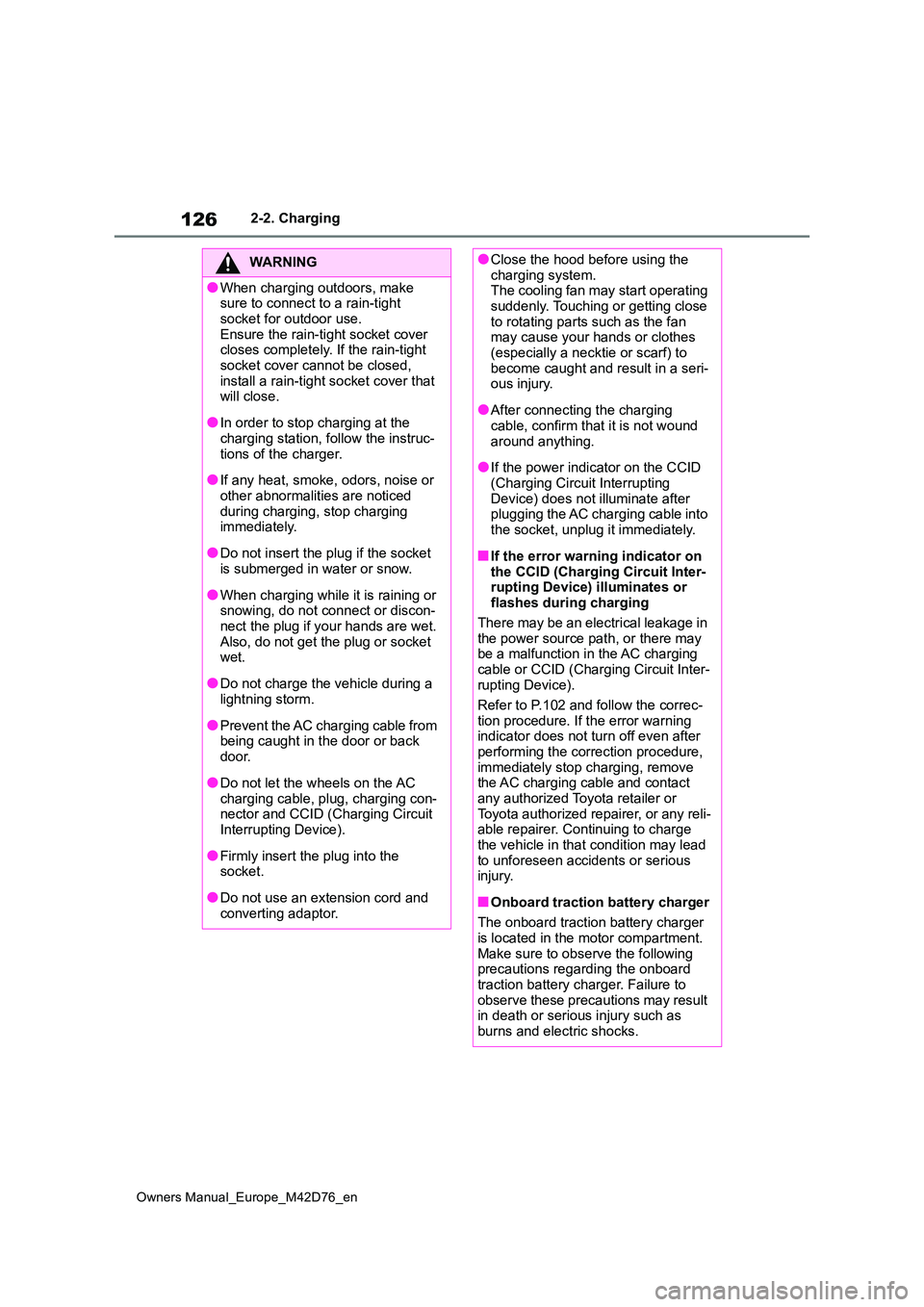
126
Owners Manual_Europe_M42D76_en
2-2. Charging
WARNING
●When charging outdoors, make sure to connect to a rain-tight
socket for outdoor use. Ensure the rain-tight socket cover closes completely. If the rain-tight
socket cover cannot be closed, install a rain-tight socket cover that will close.
●In order to stop charging at the charging station, follow the instruc-
tions of the charger.
●If any heat, smoke, odors, noise or
other abnormalities are noticed during charging, stop charging immediately.
●Do not insert the plug if the socket is submerged in water or snow.
●When charging while it is raining or snowing, do not connect or discon-
nect the plug if your hands are wet. Also, do not get the plug or socket wet.
●Do not charge the vehicle during a lightning storm.
●Prevent the AC charging cable from being caught in the door or back
door.
●Do not let the wheels on the AC
charging cable, plug, charging con- nector and CCID (Charging Circuit Interrupting Device).
●Firmly insert the plug into the socket.
●Do not use an extension cord and converting adaptor.
●Close the hood before using the charging system.The cooling fan may start operating
suddenly. Touching or getting close to rotating parts such as the fan may cause your hands or clothes
(especially a necktie or scarf) to become caught and result in a seri-ous injury.
●After connecting the charging cable, confirm that it is not wound
around anything.
●If the power indicator on the CCID
(Charging Circuit Interrupting Device) does not illuminate after plugging the AC charging cable into
the socket, unplug it immediately.
■If the error warning indicator on
the CCID (Charging Circuit Inter- rupting Device) illuminates or flashes during charging
There may be an electrical leakage in the power source path, or there may be a malfunction in the AC charging
cable or CCID (Charging Circuit Inter- rupting Device).
Refer to P.102 and follow the correc-
tion procedure. If the error warning indicator does not turn off even after performing the correction procedure,
immediately stop charging, remove the AC charging cable and contact any authorized Toyota retailer or
Toyota authorized repairer, or any reli- able repairer. Continuing to charge the vehicle in that condition may lead
to unforeseen accidents or serious injury.
■Onboard traction battery charger
The onboard traction battery charger is located in the motor compartment.
Make sure to observe the following precautions regarding the onboard traction battery charger. Failure to
observe these precautions may result in death or serious injury such as burns and electric shocks.
Page 129 of 674
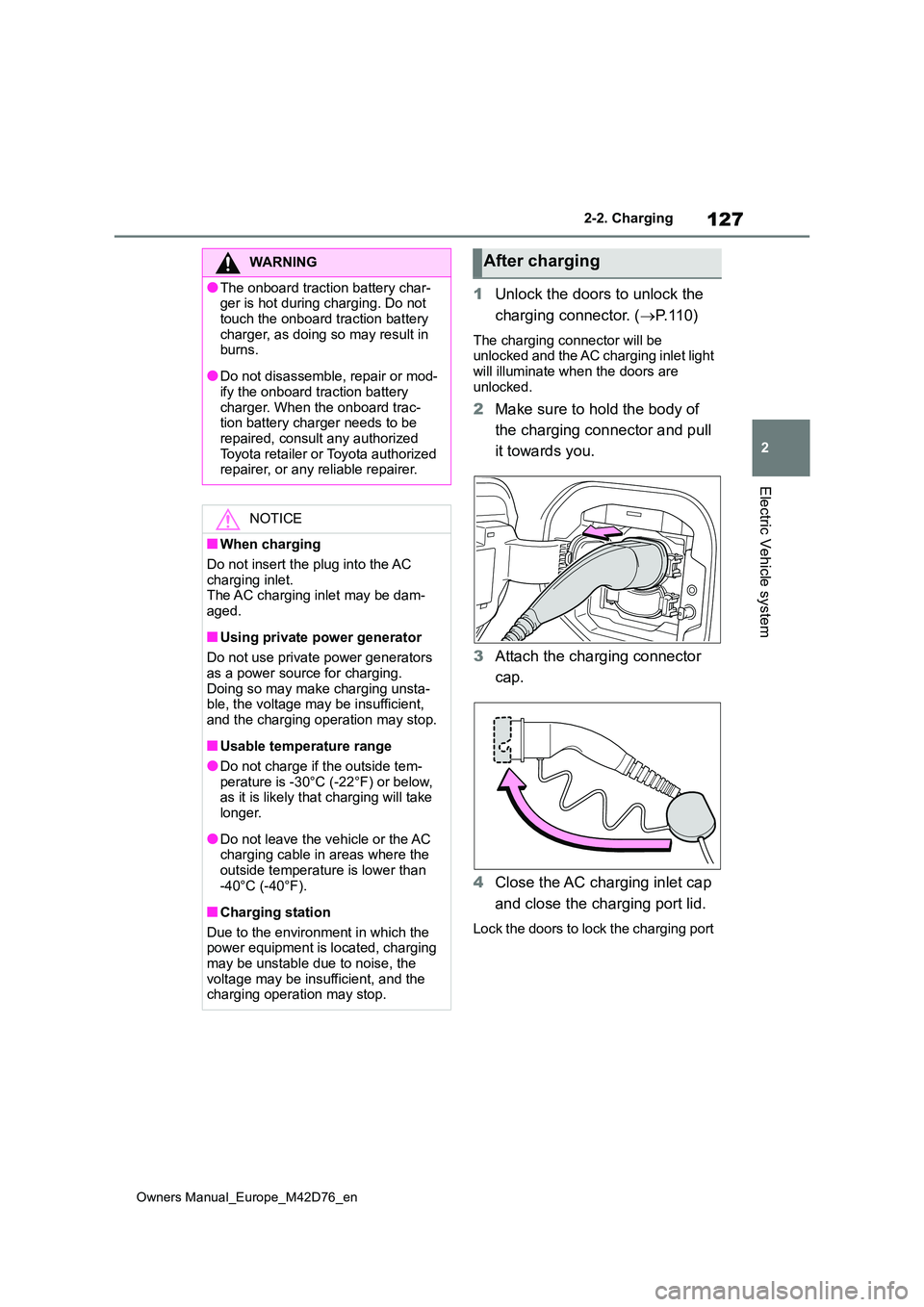
127
2
Owners Manual_Europe_M42D76_en
2-2. Charging
Electric Vehicle system
1Unlock the doors to unlock the
charging connector. ( P. 1 1 0 )
The charging connector will be unlocked and the AC charging inlet light
will illuminate when the doors are unlocked.
2 Make sure to hold the body of
the charging connector and pull
it towards you.
3 Attach the charging connector
cap.
4 Close the AC charging inlet cap
and close the charging port lid.
Lock the doors to lock the charging port
WARNING
●The onboard traction battery char- ger is hot during charging. Do not
touch the onboard traction battery charger, as doing so may result in burns.
●Do not disassemble, repair or mod-ify the onboard traction battery
charger. When the onboard trac- tion battery charger needs to be repaired, consult any authorized
Toyota retailer or Toyota authorized repairer, or any reliable repairer.
NOTICE
■When charging
Do not insert the plug into the AC charging inlet.The AC charging inlet may be dam-
aged.
■Using private power generator
Do not use private power generators as a power source for charging.
Doing so may make charging unsta- ble, the voltage may be insufficient, and the charging operation may stop.
■Usable temperature range
●Do not charge if the outside tem-
perature is -30°C (-22°F) or below, as it is likely that charging will take longer.
●Do not leave the vehicle or the AC charging cable in areas where the
outside temperature is lower than -40°C (-40°F).
■Charging station
Due to the environment in which the power equipment is located, charging
may be unstable due to noise, the voltage may be insufficient, and the charging operation may stop.
After charging
Page 130 of 674
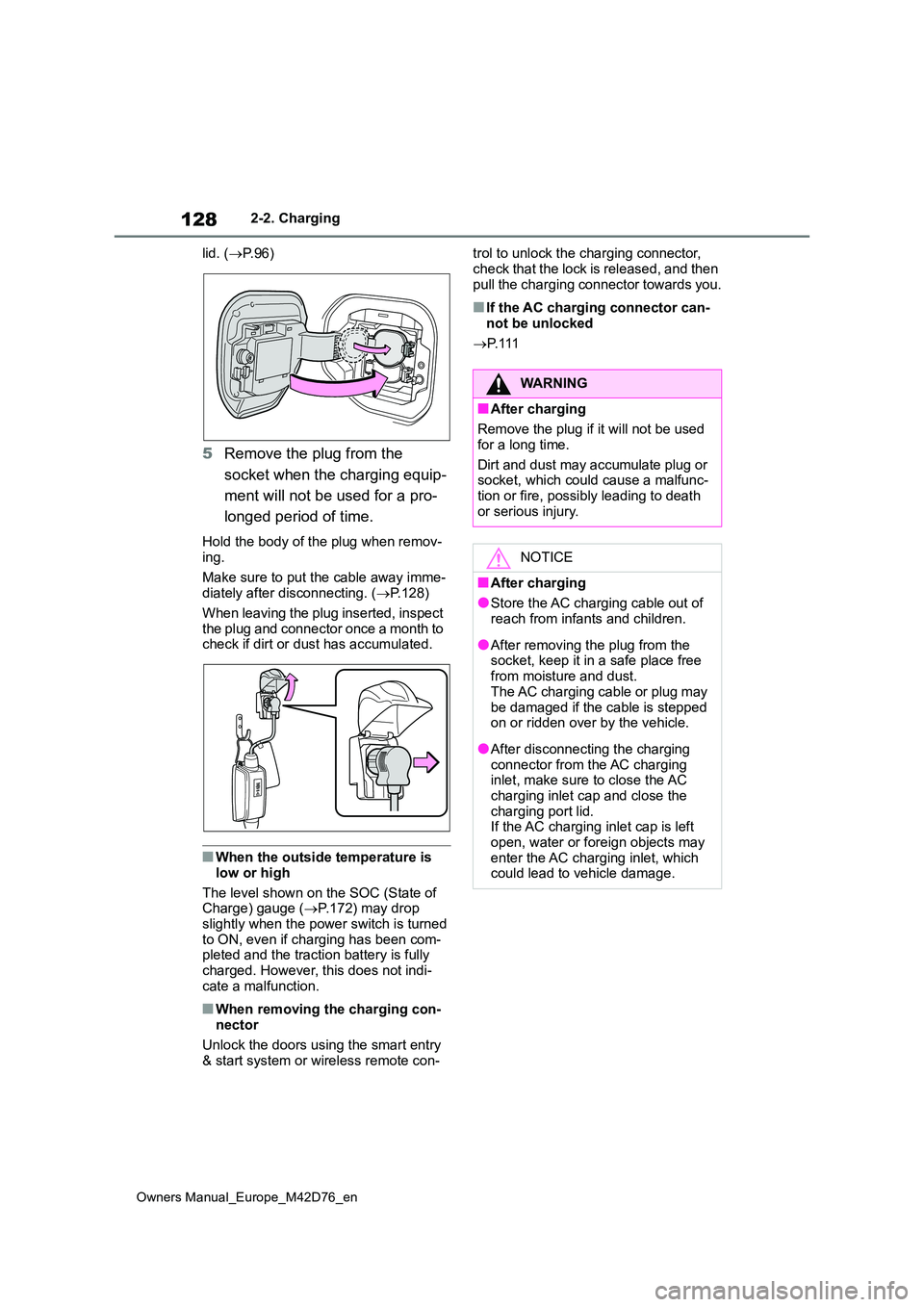
128
Owners Manual_Europe_M42D76_en
2-2. Charging
lid. ( P. 9 6 )
5Remove the plug from the
socket when the charging equip-
ment will not be used for a pro-
longed period of time.
Hold the body of the plug when remov- ing.
Make sure to put the cable away imme- diately after disconnecting. ( P.128)
When leaving the plug inserted, inspect
the plug and connector once a month to check if dirt or dust has accumulated.
■When the outside temperature is
low or high
The level shown on the SOC (State of Charge) gauge ( P.172) may drop
slightly when the power switch is turned to ON, even if charging has been com-pleted and the traction battery is fully
charged. However, this does not indi- cate a malfunction.
■When removing the charging con-nector
Unlock the doors using the smart entry & start system or wireless remote con-
trol to unlock the charging connector,
check that the lock is released, and then pull the charging connector towards you.
■If the AC charging connector can-not be unlocked
P. 1 1 1
WARNING
■After charging
Remove the plug if it will not be used
for a long time.
Dirt and dust may accumulate plug or socket, which could cause a malfunc-
tion or fire, possibly leading to death or serious injury.
NOTICE
■After charging
●Store the AC charging cable out of reach from infants and children.
●After removing the plug from the socket, keep it in a safe place free
from moisture and dust. The AC charging cable or plug may
be damaged if the cable is stepped on or ridden over by the vehicle.
●After disconnecting the charging connector from the AC charging inlet, make sure to close the AC
charging inlet cap and close the charging port lid.If the AC charging inlet cap is left
open, water or foreign objects may enter the AC charging inlet, which could lead to vehicle damage.